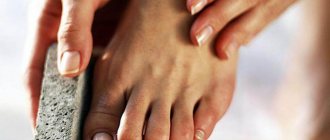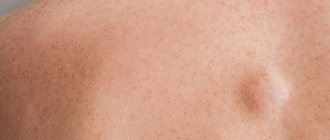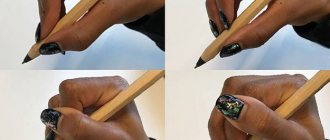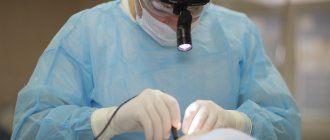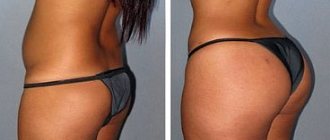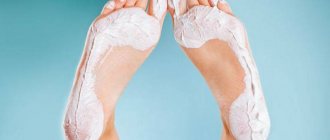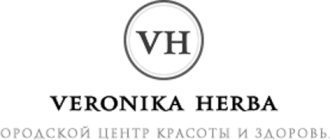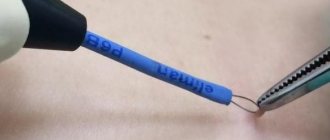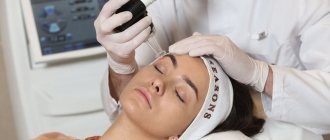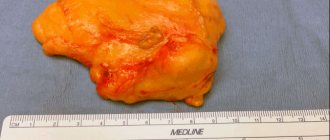Medical diagnosis of callus
Core-type calluses are fairly easy to diagnose.
After an in-person consultation, a dermatologist can provide a conclusion and diagnosis about the type of skin growth.
The only difficulty may be differentiating an ingrown callus from Verruca plantaris (plantar wart).
Because they have the same location and appearance.
You can distinguish a callus from a wart by the following features:
- An ingrown callus is not accompanied by bleeding even with strong pressure on it.
- A wart, unlike a callus, is not a single formation. Typically, upon examination, several warts that resemble cauliflower can be identified.
- The callus in its central zone has a small depression, which can be seen upon detailed examination. In the case of a wart, the HPV formation consists of thin fibers; petechiae (black dots) are observed on top, which bleed when injured.
- If a wart is present, pain occurs when the lesion itself is palpated; there is no pain when walking. In the case of calluses, pain is observed with any mechanical movement.
To confirm the diagnosis and determine the cause of the disease, the dermatologist prescribes a blood test for diabetes mellitus.
Also an analysis to determine the human papillomavirus, to exclude HPV.
Additionally, the doctor can redirect the patient to other specialized specialists.
See a podiatrist (a doctor who treats foot pathologies), a rheumatologist or an orthopedist.
An important point is to exclude Morton's neuroma.
Morton's neuroma is a benign or non-cancerous growth of fibrous tissue.
Develops in the area of the tibial nerve, most often between the third and fourth fingers.
The pathology is accompanied by thickening of the plantar nerve, pain when walking, and a feeling of numbness in the fingers.
The disease is also known as Morton's metatarsalgia, plantar neuroma, and intermetatasal neuroma.
Methods for treating and removing ingrown calluses
The only and effective method of eliminating this problem on the legs is to remove the stratum corneum of the callus and its root.
In this case, it is important to completely remove not only the surface of the callus, but also the root.
Otherwise, the risk of relapse reaches 100%.
There are various methods for removing calluses; the optimal treatment option is selected individually.
Depending on the clinical signs, the neglect of the case and how deep the root has penetrated into the layers of the dermis.
Prevention
You can avoid a situation with a negative manifestation by following the basic rules of hand skin care. When working with harmful or chemical products, gloves must be worn.
This is a must when working with heavy loads. In this case, you will be able to avoid rubbing on your palms and fingers. It is important to use moisturizer and pumice stone regularly.
With timely prevention, it will be possible to maintain the condition of the skin of your hands in perfect condition for many years. Otherwise, funds will have to be allocated for treatment.
Removing callus using drilling
This procedure can be carried out in a pedicure salon.
During the manipulation, a special device resembling a drill is used.
The procedure does not require the use of anesthesia.
Since it is not accompanied by pain.
Drilling/excision of callus areas is carried out using special attachments.
An antibacterial ointment is first placed in the deepening of the callus to prevent the development of the inflammatory process.
For the first few days, the patient may feel minor discomfort, which goes away on its own and does not require treatment.
Dry callus is removed using a similar method, but provided that it is not neglected.
The drilling procedure has certain disadvantages:
- If the rod is located deep enough, this manipulation may be ineffective. Often several manipulations are required to completely remove the callus.
- In the process of drilling out the keratinized area of the dermis, damage to healthy skin is possible. The procedure requires a highly qualified specialist.
- This type of callus removal is a contact type of procedure, which means it is accompanied by an increased risk of infection.
Reasons for the formation of calluses on the finger
Dry crusts or wet blisters may appear on the skin under the influence of negative external and internal factors. The process is not always directly related to an increase in the intensity of physical labor.
The selection of a course of treatment should be made only after determining the cause of the development of the clinical picture in a negative way. Calluses on the fingers appear under the influence of the following factors:
- Excessive physical activity negatively affects the condition of the skin. Calluses are a consequence of active sports, doing housework, repairs or construction. Against this background, growths with lymphatic fluid often occur.
It is recommended to reduce the load. Otherwise, blood may begin to collect inside the formation. Additionally, the risk of secondary infection also increases. - Often, calluses on the fingers can be found in seamstresses, carpenters or turners. The formations are formed through regular friction against the surface of the skin. In secretaries, the symptom appears on the fingertips, and in students, chafing occurs from a ballpoint pen.
- The condition of the epidermis worsens when there is a lack of vitamins A and E in the body. In this case, the skin cannot withstand excessive stress. Preventive intake of vitamin complexes, which is recommended once every 12 months, will help to avoid the situation.
How to get rid of calluses on your fingers, watch this video:
Types of formations
The callus must be correctly identified.
Only after this will the dermatologist be able to choose the right course of treatment. Today in medical practice, education is differentiated into the following types:
- A large amount of fluid accumulates inside the dropsy. They occur due to excessive physical activity or friction. After a few days, the callus ruptures and after that the stage of active healing of the skin begins.
- Dry callus is the result of moderate friction. Thanks to him, the skin tries to rid itself of injury. They are much more difficult to eliminate than the previous type.
- The rod is characterized by the presence of a root that penetrates deep into the skin. The lesion is serious and requires immediate surgical removal.
How to delete
Thanks to the qualified help of a doctor, you can quickly get rid of calluses:
- The rod formation is eliminated by drilling, laser burning, cryodestruction or electrocoagulation.
- Only a surgeon can help eliminate a purulent callus. Without timely assistance, the risk of developing suppuration increases.
Traditional medicine
Any pharmacy offers a wide range of medications that will help get rid of the blister within a few days. During the treatment process, you should adhere to a number of simple rules:
- A weeping blister is dangerous due to the increased risk of spreading a secondary infection.
Treatment with an antiseptic (hydrogen peroxide, furacilin, chlorhexidine) will help prevent its development. The use of antibacterial ointments (levomekol, liniment, syntomycin) is allowed. After applying the drug to the affected area, it is necessary to additionally stick a patch. It is forbidden to open the bladder yourself, otherwise inflammation may develop. - Dry calluses will first need to be softened. It is recommended to steam the skin first. An ointment, special liquid or patch is suitable for this. They usually contain salicylic or benzoic acid. During use, you must be extremely careful, as there is a risk of damage to healthy areas. The callus is removed using pumice after 12-72 hours.
- Trichloroacetic acid is a radical agent. It should be used very carefully. Otherwise, a chemical burn may occur. The composition is suitable for eliminating dry calluses. Trichloroacetic acid should be applied to the affected area after preliminary softening once a day.
This video will tell you how to treat calluses:
Folk remedies
To remove calluses, you can also use all-natural ingredients. Most often, aloe juice is used for this. The leaves of the plant are peeled and crushed.
The resulting composition should be applied to the affected area. Swelling, pain and inflammation disappear within a few days. Additionally, the process of natural tissue regeneration starts.
Aloe juice helps destroy harmful bacteria and microorganisms.
To eliminate calluses and the consequences of their formation, it is recommended to use one of the following traditional medicine methods:
- Celandine juice helps get rid of many skin diseases. Calluses and warts are no exception. It is recommended to apply the composition to the affected surface once a day.
- Aloe helps not only relieve inflammation in wet blisters, but also soften the upper part of the epidermis in dry ones. Regular use guarantees painless removal of keratinized tissue.
- Chopped garlic helps get rid of calluses. The resulting composition is best applied to the affected area at night.
- To nourish and moisturize the skin, it is recommended to use calendula compresses. To prepare the healing composition, it is recommended to use exclusively the flowers of the plant.
- Propolis has a positive effect on the condition of the skin. Before use, it must be warmed well and wrapped in gauze. To secure it, you should use a regular plaster.
- A bath of soap and soda helps soften rough areas.
To prepare it, take three tablespoons of powder, add a little soap shavings and warm boiled water. A positive result can only be achieved if the procedure is carried out for at least 15 minutes. - Oat straw has long been used to remove calluses. It must be filled with water and boiled for 10 minutes. The resulting composition is poured into a basin, in which further steaming will take place. After manipulation, the callus will become dry, so it can be easily removed from the skin. For this it is advisable to use pumice.
- For the bath you will need to take 2 liters of warm water and add two tablespoons of sea salt to it. The positive effect will be noticeable if you steam your palms for 25 minutes. After completing the procedure, hands should be thoroughly lubricated with moisturizing cream.
When using traditional medicine methods, one should not forget that they can cause an allergic reaction. Most often, individual intolerance in people is fixed to honey and herbal components.
Before starting any procedure, you need to apply a small amount of the composition to the crook of your arm.
The method should be abandoned if there is redness or burns. The abuse of organic acids is also dangerous. Excessive amounts of acetic or citric acid can leave a mark on the skin.
When using them, you must strictly adhere to the dosage indicated in the recipe. Otherwise, the risk of complications, scars and burns increases. They can remain on a person's skin for life.
Removal of callus with liquid nitrogen (cryodestruction)
Cryodestruction is an innovative, highly effective method of removing calluses on the foot, heel or toes using liquid nitrogen.
During the procedure, the keratinized area of the skin is frozen, after which the destruction of the callus is observed.
It has been noted that the procedure is associated with an extremely low rate of callus re-development.
Many dermatologists note that no other method for removing core calluses gives results as favorable as cryodestruction.
Removing callus with liquid nitrogen takes about 10-20 minutes.
It is performed under local anesthesia, so the procedure is completely painless and safe.
Side effects are extremely rare (no more than 3% of cases).
Include callus recurrence, pain, discomfort, bleeding, infection, scarring.
The first few days after the procedure, the formation of a cold bubble is observed, which under no circumstances should be pierced.
Within 10-14 days, the healing process occurs; a crust forms in place of the bubble, which falls off on its own.
The process is not accompanied by the formation of scars.
The procedure is usually well tolerated, with minor discomfort possible.
Some disadvantages of cryotherapy:
- If the rod is extremely deep, cryodestruction is not always able to completely rid the patient of the callus.
- If you do not properly care for the skin after the procedure, there is a risk of an infectious process.
- Freezing the callus with liquid nitrogen is not used when large areas of the epidermis are affected. Cryodestruction used on large calluses can lead to a number of complications. For this reason, in advanced cases, they resort to other therapeutic methods.
Cost of laser callus removal
| Laser tumor removal | Prices, rub. |
| Laser removal of papillomas, single warts - Cat. I. difficulties | 1200 |
| Laser removal of papillomas, multiple warts - Cat. I. difficulties | 350 |
| Laser removal of moles, papillomas, warts - Cat. II. difficulties | 700 |
| Laser removal of moles, papillomas, warts - Cat. III. difficulties | 1500 |
| Laser removal of moles, papillomas, warts - IV category. difficulties | 3000 |
| Laser removal of moles, papillomas, warts - Cat. V. difficulties | 4500 |
| Laser removal of moles, papillomas, warts - Cat. VI. difficulties | 6100 |
| CO2 Laser callus removal (per unit) | 6100 |
| Removal of atheroma, lipoma, fibroma, xanthelasma with laser - Cat. I. difficulties | 6 900 |
| Removal of atheroma, basal cell carcinoma, lipoma, fibroma, xanthelasma with laser - Category II. difficulties | 9 400 |
| Removal of atheroma, basal cell carcinoma, lipoma, fibroma, xanthelasma with laser - Cat. III. difficulties | 16 900 |
| Removal of atheroma, basal cell carcinoma, lipoma, fibroma, xanthelasma with laser - IV category. difficulties | 22 400 |
| Removal of atheroma, basal cell carcinoma, lipoma, fibroma, xanthelasma with laser - Cat. V. difficulties | 33 400 |
Sign up for laser removal of hard calluses
- Full name
- Telephone
Treatment methods
Radical treatment of hard calluses involves their removal. Removal is carried out using different methods:
- laser;
- surgically;
- radio wave method;
- cryodestruction.
Cryodestruction is the removal of a tumor by freezing tissue with liquid nitrogen. After such treatment, the frozen particles, along with the rod, peel off. This removal method is not the most pleasant. The radio wave method is removal under the influence of high temperatures. The callus is simply burned off under local anesthesia. The method has the disadvantage of a long rehabilitation period.
Hard, late-stage calluses can be removed with surgery. Only radical removal with a scalpel helps solve the problem. This treatment also involves long-term rehabilitation. The most positive reviews were left about the laser removal procedure.
Advantages of laser destruction
Hard calluses can be removed using a laser. Under the influence of a laser beam, dead skin particles and the stem evaporate. The laser has several advantages:
- The treatment is completely safe, there is no risk of harming healthy tissue. The laser penetration depth is controlled.
- The treatment does not carry the risk of infection, there is no contact of the instrument with the body.
- There are no open wounds or bleeding - the blood instantly stops under the influence of the laser.
- Treatment does not take much time.
- The problem is solved radically in one session.
- The laser eliminates even very hard formations that are difficult to treat.
- Rehabilitation after the session is short - only a few days.
Before and after laser callus removal
Laser excision of callus
Laser callus removal remains a priority treatment method.
Allows you to effectively eliminate the problem with minimal risk of recurrence.
The laser penetrates into the deep layers of the dermis, which makes it possible to remove the root completely, rather than partially.
The operation of the device is based on the reproduction of a laser beam with special light properties:
- Monochromatic: Has only one specific wavelength or color.
- Coherence: Vibrates in the same phase or synchronously.
- Divergence: the beam works in a given direction.
During the manipulation, the epidermal layer is “burned out”, one after another.
The manipulation requires the use of an anesthetic.
The average session duration is no more than 10-15 minutes.
Before using the laser, the callus is treated with antiseptic drugs.
After laser irradiation, a dense crust forms, which will disappear after 10-14 days.
Laser treatment to remove calluses leads to cell regeneration.
It has an anti-inflammatory effect and stimulates the local immune system.
Thus, it promotes rapid healing of wounds.
However, the main advantage of the laser is the complete removal of callus even with a deep root location.
Often, one visit to a dermatologist is enough to effectively eliminate the problem.
Radio wave removal of callus
Callus removal by radio wave is carried out using a special device “Surgitron”.
The Surgitron device uses advanced radio wave technology.
Ensures accuracy, versatility and safety of medical procedures.
The surgical electrode, which is a tungsten wire, emits 3.8 MHz radio waves and slides through the tissue without putting pressure on it.
The pathologically changed area is evaporated, which leads to the destruction of the callus.
An important advantage is that the electrode is self-sterilizing during use, which reduces the likelihood of infection after the procedure.
Other benefits of radio wave treatment:
- Excellent cosmetic results; the manipulation is not accompanied by the formation of scar tissue.
- Fast recovery for the patient, since the treatment process does not affect the healthy tissue surrounding the callus.
- Reduced postoperative pain; in addition, the manipulation itself is not accompanied by pain.
After radio wave removal, the callus becomes covered with a crust, which falls off on its own after 7-10 days.
After which a new, healthy layer of new skin appears, which over time blends with the natural color of the epidermis.
Treatment of callus with medications
It is immediately worth noting that drug treatment of calluses has the least therapeutic effectiveness.
This phenomenon is associated with the inability of drugs to penetrate deep into tissues, eliminating the root of the formation.
The products used for core calluses often contain keratolytic components and can be effective at the beginning of callus development.
As a rule, products based on salicylic acid are used.
Salicylic acid is a keratoplastic and keratolytic agent.
In addition, it has an antibacterial and antifungal effect.
Salicylic acid works by softening keratin, a natural protein that is part of the skin's structure and produced by the body.
The drug has a softening effect on the stratum corneum of the dermis, which facilitates its removal.
Salicylic acid is often used in combination with other substances.
Allows for a higher therapeutic effect.
When using salicylic acid preparations, the simultaneous use of the following drugs is not recommended:
- Alcohol-containing medications.
- Any other local medications that contain dibenzoyl peroxide or retinoid.
- Soapy substances that have a drying effect.
- Cosmetics that have an exfoliating effect.
Traditional medicine in the treatment of calluses
Folk remedies cannot affect the development of callus and are not an effective treatment method.
The treatment and removal of callus must be carried out by a qualified specialist.
This will minimize negative consequences and complications.
It is necessary to begin treatment of callus in the early stages of its development.
When there is still a chance to get rid of the problem without resorting to surgical methods.
As it progresses, the root of the callus will penetrate into the deeper layers of the epidermis.
Then it may be necessary to use more radical and expensive methods of therapy.
How to choose the right ointment against calluses?
In home treatment, the drug is selected taking into account the type of callosal defect:
- Ointments with a moisturizing, softening, and keratolytic effect will help with corns and dry calluses. Therapeutic agents enhance desquamation - exfoliation of dead skin flakes, activate blood microcirculation, and soften damaged areas.
- For shallow core calluses, keratolytic preparations are used to loosen the keratinized epidermis, and local anesthetics to eliminate pain.
- For water calluses, burst blisters, and areas worn down to the flesh, use antibacterial anti-inflammatory drugs that have a drying and wound-healing effect. And also, reparants and regenerants for skin restoration.
For bloody calluses resulting from tissue compression, treatment with antiseptics is necessary. An infection easily penetrates into a burst blood callus, which can lead to suppuration, inflammation of the lymph nodes, and sepsis (blood poisoning).
Benefits of ointment treatment:
- accessibility (you don’t need a doctor’s prescription to purchase the product);
- therapeutic effect to accelerate the healing of the epidermis;
- wide choice of directional action;
- acceptable price category.
Important!
Medicines for external use do not have direct contact with the digestive organs, which significantly reduces the list of contraindications for their use. When self-treating with topical drugs, you must:
- follow the instructions for use;
- before use, perform an allergy test on the inner bend of the elbow joint;
- After opening the package, store the ointment in the refrigerator.
